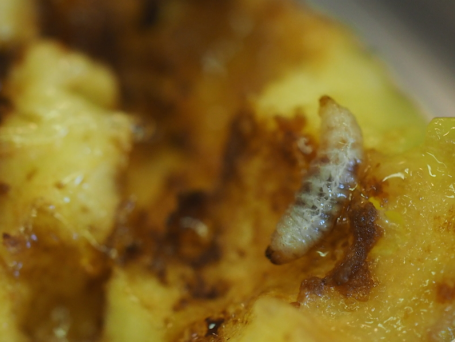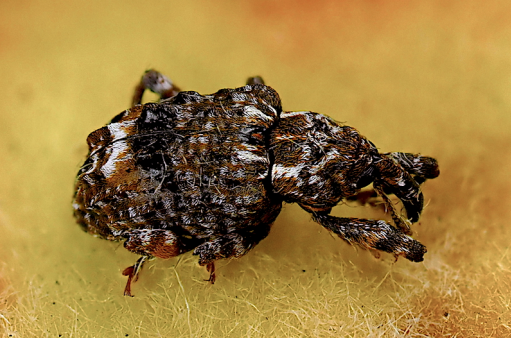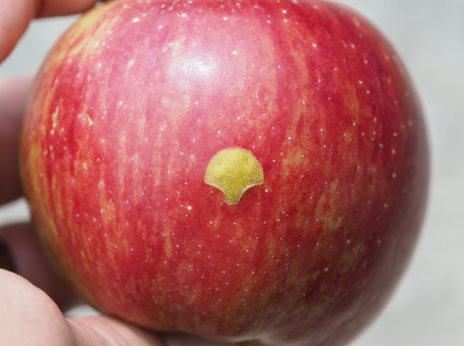Conotrachelus nenuphar (Herbst)
Author: Brett Blaauw, Fruit Entomologist, University of Georgia, 2021
Description
Immature stages: The larvae tunnel and feed in developing fruit, usually boring to the pit. Larvae are yellowish-white, legless, brownheaded grubs, about 3/8 inch (6-9 mm) long when fully grown.
Adult stages: Adults are small, about 1/4 inch (4-6 mm) long, brownish-black snout beetles, mottled with lighter gray or brown markings. Their backs are roughened and bear two prominent humps and two smaller humps.
Biology
Life Cycle: Plum curculio is a snout beetle native to North America and is found east of the Rocky Mountains in the United States and Canada. Early spring in the Southeast, the female plum curculio begins depositing eggs singly in a hole that she creates in the fruit at shuck split in peaches. The egg hatches in about five days and the larva feeds in the fruit for eight to twenty-two days. The full-grown larva tunnels out of the peach, enters the soil transforming into a pupa. The first generation adults usually emerge about four weeks after larvae enter the soil. The complete life cycle, from egg to emerged adult, requires five to eight weeks, depending upon climatic conditions.
Seasonal Distribution: There are 2 generations of plum curculio in GA each season. The overwintering adults emerge and begin migrating into the orchards in March, around shuck split in peaches. The first within-field generation emerges from the soil in June and begin attacking the maturing fruit. These are the larvae that are often found in July harvested fruit. The second generation emerges from the soil in mid-August. Both first and second generation adults feed on foliage or fruit until cool weather, when they seek overwintering sites.
Damage
Plum curculios have a wide host range, but adults attack primarily pome and stone fruits, such as apples, pears, peaches, and plums. Once a female finds a suitable host, she will slice a curved slit underneath the skin of the fruit where she will deposit her egg. As the fruit continues to grow, this deposition causes a crescent-shaped
scar on the outside of the fruit.
The larvae tunnel and feed in developing fruit, usually boring to the pit. Most peaches infested by plum curculio early in the season drop prematurely. Female curculios will deposit eggs whenever fruits are available, but they prefer small, young peaches or peaches within two weeks of harvest. Larger peaches, infested after pit hardening begins, generally stay on the tree until ripe, but these wormy fruit are of no value due to the flesh damage and/or presence of the grubs.
Management
Insecticide sprays for plum curculio management are normally initiated at shuck split. Once maximum daily temperatures reach 70oF for two consecutive days from February to early March, begin accumulating daily degree days (DD, base 50oF). Two or three additional sprays at 10- to 14-day intervals are needed to assure control of the overwintered population. Migration of adults into the orchard continues from 50 to 500 DD, so this is the period when fruit should be protected by insecticide sprays. Summer adults emerge from the soil after 1,000 DD. Special attention should be given to mid- and late-season cultivars by applying insecticide sprays at six, four, and two weeks before harvest.
Keeping the orchard floor closely mowed after harvest affords less protective cover to adults that overwinter in the orchard. Destruction of nearby plum thickets, abandoned peach blocks, and other alternate hosts is suggested to reduce plum curculio migration into orchards from outside sources.


